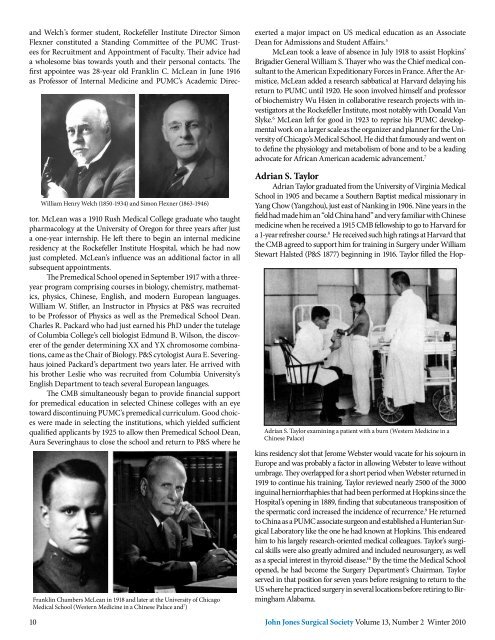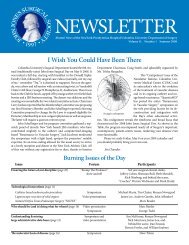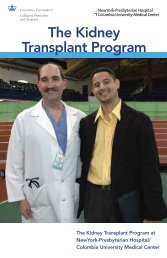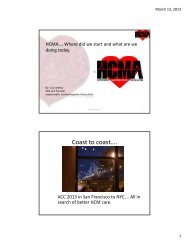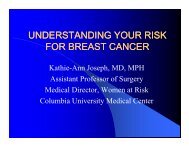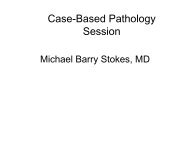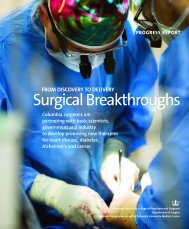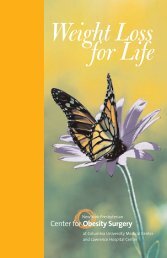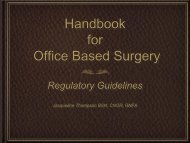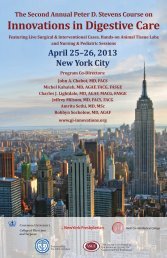NEWSLETTER - Columbia University Department of Surgery
NEWSLETTER - Columbia University Department of Surgery
NEWSLETTER - Columbia University Department of Surgery
Create successful ePaper yourself
Turn your PDF publications into a flip-book with our unique Google optimized e-Paper software.
and Welch’s former student, Rockefeller Institute Director Simon<br />
Flexner constituted a Standing Committee <strong>of</strong> the PUMC Trustees<br />
for Recruitment and Appointment <strong>of</strong> Faculty. Their advice had<br />
a wholesome bias towards youth and their personal contacts. The<br />
first appointee was 28-year old Franklin C. McLean in June 1916<br />
as Pr<strong>of</strong>essor <strong>of</strong> Internal Medicine and PUMC’s Academic Direc-<br />
William Henry Welch (1850-1934) and Simon Flexner (1863-1946)<br />
tor. McLean was a 1910 Rush Medical College graduate who taught<br />
pharmacology at the <strong>University</strong> <strong>of</strong> Oregon for three years after just<br />
a one-year internship. He left there to begin an internal medicine<br />
residency at the Rockefeller Institute Hospital, which he had now<br />
just completed. McLean’s influence was an additional factor in all<br />
subsequent appointments.<br />
The Premedical School opened in September 1917 with a threeyear<br />
program comprising courses in biology, chemistry, mathematics,<br />
physics, Chinese, English, and modern European languages.<br />
William W. Stifler, an Instructor in Physics at P&S was recruited<br />
to be Pr<strong>of</strong>essor <strong>of</strong> Physics as well as the Premedical School Dean.<br />
Charles R. Packard who had just earned his PhD under the tutelage<br />
<strong>of</strong> <strong>Columbia</strong> College’s cell biologist Edmund B. Wilson, the discoverer<br />
<strong>of</strong> the gender determining XX and YX chromosome combinations,<br />
came as the Chair <strong>of</strong> Biology. P&S cytologist Aura E. Severinghaus<br />
joined Packard’s department two years later. He arrived with<br />
his brother Leslie who was recruited from <strong>Columbia</strong> <strong>University</strong>’s<br />
English <strong>Department</strong> to teach several European languages.<br />
The CMB simultaneously began to provide financial support<br />
for premedical education in selected Chinese colleges with an eye<br />
toward discontinuing PUMC’s premedical curriculum. Good choices<br />
were made in selecting the institutions, which yielded sufficient<br />
qualified applicants by 1925 to allow then Premedical School Dean,<br />
Aura Severinghaus to close the school and return to P&S where he<br />
Franklin Chambers McLean in 1918 and later at the <strong>University</strong> <strong>of</strong> Chicago<br />
Medical School (Western Medicine in a Chinese Palace and 7 )<br />
exerted a major impact on US medical education as an Associate<br />
Dean for Admissions and Student Affairs. 5<br />
McLean took a leave <strong>of</strong> absence in July 1918 to assist Hopkins’<br />
Brigadier General William S. Thayer who was the Chief medical consultant<br />
to the American Expeditionary Forces in France. After the Armistice,<br />
McLean added a research sabbatical at Harvard delaying his<br />
return to PUMC until 1920. He soon involved himself and pr<strong>of</strong>essor<br />
<strong>of</strong> biochemistry Wu Hsien in collaborative research projects with investigators<br />
at the Rockefeller Institute, most notably with Donald Van<br />
Slyke. 6 McLean left for good in 1923 to reprise his PUMC developmental<br />
work on a larger scale as the organizer and planner for the <strong>University</strong><br />
<strong>of</strong> Chicago’s Medical School. He did that famously and went on<br />
to define the physiology and metabolism <strong>of</strong> bone and to be a leading<br />
advocate for African American academic advancement. 7<br />
Adrian S. Taylor<br />
Adrian Taylor graduated from the <strong>University</strong> <strong>of</strong> Virginia Medical<br />
School in 1905 and became a Southern Baptist medical missionary in<br />
Yang Chow (Yangzhou), just east <strong>of</strong> Nanking in 1906. Nine years in the<br />
field had made him an “old China hand” and very familiar with Chinese<br />
medicine when he received a 1915 CMB fellowship to go to Harvard for<br />
a 1-year refresher course. 8 He received such high ratings at Harvard that<br />
the CMB agreed to support him for training in <strong>Surgery</strong> under William<br />
Stewart Halsted (P&S 1877) beginning in 1916. Taylor filled the Hop-<br />
Adrian S. Taylor examining a patient with a burn (Western Medicine in a<br />
Chinese Palace)<br />
kins residency slot that Jerome Webster would vacate for his sojourn in<br />
Europe and was probably a factor in allowing Webster to leave without<br />
umbrage. They overlapped for a short period when Webster returned in<br />
1919 to continue his training. Taylor reviewed nearly 2500 <strong>of</strong> the 3000<br />
inguinal herniorrhaphies that had been performed at Hopkins since the<br />
Hospital’s opening in 1889, finding that subcutaneous transposition <strong>of</strong><br />
the spermatic cord increased the incidence <strong>of</strong> recurrence. 9 He returned<br />
to China as a PUMC associate surgeon and established a Hunterian Surgical<br />
Laboratory like the one he had known at Hopkins. This endeared<br />
him to his largely research-oriented medical colleagues. Taylor’s surgical<br />
skills were also greatly admired and included neurosurgery, as well<br />
as a special interest in thyroid disease. 10 By the time the Medical School<br />
opened, he had become the <strong>Surgery</strong> <strong>Department</strong>’s Chairman. Taylor<br />
served in that position for seven years before resigning to return to the<br />
US where he practiced surgery in several locations before retiring to Birmingham<br />
Alabama.<br />
10 John Jones Surgical Society Volume 13, Number 2 Winter 2010


